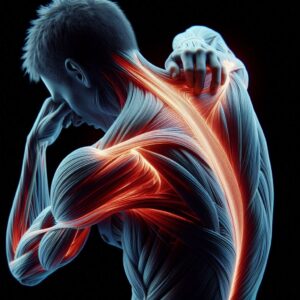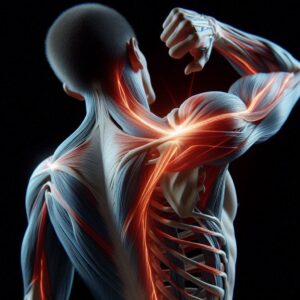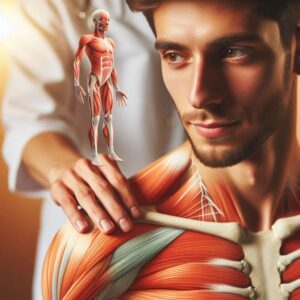Fascial Distortion Model: A Proven Approach to Treatment
The Fascial Distortion Model (FDM) is a diagnostic and treatment approach that emphasises identifying and rectifying distortions in the body’s connective tissue, called fascia. Fascia is a complex network of collagen and elastin fibres that supports muscles, organs, and structures throughout the body. Fascia distortion can lead to various symptoms, including pain, limited movement, and dysfunction in the affected area.
The FDM was created by American osteopathic physician Stephen Typaldos, D.O., in the 1990s. Dr. Typaldos noted that conventional medical approaches did not adequately address many musculoskeletal injuries and conditions, prompting him to develop a groundbreaking model for understanding and tackling these issues. The FDM categorises fascial distortions into six distinct types, each displaying unique symptoms and patterns of dysfunction.
The categories encompass Triggerband, Continuum Distortion, Cylinder Distortion, Herniated Triggerpoint, Folding Distortion, and Tectonic Fixation. The FDM distinguishes itself by focusing on the identification and treatment of specific fascial distortions through hands-on techniques rather than relying solely on imaging or other diagnostic approaches. Skilled practitioners in the FDM utilise palpation and observation techniques to identify areas of distortion within the fascia, subsequently applying focused manual therapies to address these issues effectively.
The FDM targets the underlying fascial distortions to alleviate pain, enhance function, and restore mobility in the affected body areas.
Summary
- The Fascial Distortion Model (FDM) serves as a comprehensive diagnostic and treatment framework focused on identifying and managing specific types of fascial distortions within the body.
- Fascial distortions can be identified through a comprehensive physical examination and a detailed patient history assessment—these issues frequently present as discomfort, restricted mobility, or additional symptoms.
- Treatment methods for fascial distortions can include manual therapy techniques such as manipulation, myofascial release, and exercise and movement therapies.
- The Fascial Distortion Model presents numerous benefits, including improved pain relief, increased range of motion, and faster injury recovery.
- Case studies and success stories demonstrate the effectiveness of FDM in tackling various musculoskeletal conditions and injuries.
- Integrating the Fascial Distortion Model with supplementary treatment approaches, such as physiotherapy and chiropractic care, provides a comprehensive strategy for managing patient care.
- Finding a qualified expert for Fascial Distortion Model treatment is crucial, necessitating a search for healthcare professionals with specialised training and FDM experience.
 Identifying Fascial Distortions in the Body
Identifying Fascial Distortions in the Body
Assessment Techniques
Experts skilled in FDM employ palpation and observation methods to identify specific types of fascial distortions guided by unique symptoms and patterns of dysfunction. For example, a Trigger and distortion can present as a taut, rope-like band of tissue that causes sharp, shooting pain with movement. Conversely, cylinder distortion can manifest as a swollen, sausage-shaped area of tissue that restricts movement and leads to aching or throbbing discomfort.
Assessment of Mobility and Diagnostic Imaging
In addition to palpation and observation, practitioners may employ movement assessments to identify areas of fascial distortion. By meticulously observing patients’ movements and how they perform tasks, practitioners can pinpoint areas of restricted mobility or dysfunctional movement patterns that may indicate underlying fascial distortions. Imaging studies, such as MRI or ultrasound, may be employed to confirm the presence of fascial distortions in specific cases; however, these methods are not always necessary for diagnosis.
Attention and Rehabilitation
Upon recognising fascial distortions, practitioners can develop a customised treatment plan that specifically targets these issues through focused manual therapies. These therapies may include techniques such as trigger and release, cylinder distortion reduction, or tectonic fixation reduction, all designed to precisely address each type of fascial distortion. By addressing these distortions, practitioners aim to relieve pain, improve function, and restore mobility in the affected area.
Treatment Techniques for Fascial Distortions
The treatment techniques utilised in the Fascial Distortion Model are based on precise manual therapies designed to address each type of fascial distortion specifically. These techniques encompass practical methods such as soft tissue manipulation, stretching, and mobilisation to relieve tension, reduce swelling, and restore normal function in the affected area. For example, Triggerband release techniques may involve applying pressure and stretching to the specific area to relieve tight tissue bands and reduce discomfort. Conversely, strategies for lowering cylinder distortion may employ gentle compression and mobilisation to alleviate swelling and improve mobility.
In addition to these specialised techniques, experts trained in FDM may integrate supplementary therapies such as ice or heat application, electrical stimulation, or therapeutic exercise to amplify the advantages of manual treatment and promote healing in the affected area. These complementary therapies are employed with manual techniques to address pain, inflammation, and dysfunction associated with fascial distortions. Treatment techniques in the FDM are tailored to each patient, considering their type of fascial distortion, individual symptoms, and patterns of dysfunction.
This customised approach allows professionals to effectively address the underlying pain and dysfunction issues, leading to enhanced patient results.
 Benefits of the Fascial Distortion Model
Benefits of the Fascial Distortion Model
The Fascial Distortion Model offers various benefits for those seeking relief from musculoskeletal pain and dysfunction. The FDM provides a notable benefit by focusing on the identification and treatment of specific fascial distortions that conventional medical approaches may overlook or misdiagnose. By tackling these core issues, the FDM aims to provide more effective relief from pain and dysfunction than traditional treatments, which frequently concentrate only on symptoms rather than addressing the root cause.
The FDM offers a significant benefit by emphasising practical manual therapies, which can provide immediate pain relief and improve functionality in the affected area. Many patients experience significant pain relief and improved mobility after just one or two sessions with a practitioner experienced in the FDM approach. This prompt response to treatment can be especially beneficial for those who have experienced chronic pain or limited mobility for an extended period.
FDM offers a customised treatment strategy that considers each patient’s unique symptoms and dysfunction patterns. By tailoring treatment approaches to address specific types of fascial distortions in each individual, practitioners proficient in FDM can provide more targeted and effective care that addresses the underlying causes of pain and dysfunction.
Case Studies and Success Stories
Many case studies and success stories illustrate the efficacy of the Fascial Distortion Model in relieving musculoskeletal pain and dysfunction. A case study published in the Journal of Bodywork and Movement Therapies presented a patient experiencing chronic low back pain who achieved significant relief after just two sessions of FDM treatment. The patient had pursued various conventional therapies without attaining the expected outcomes. Following FDM treatment targeting specific fascial distortions in the lower back, they reported a notable reduction in pain and improved mobility.
A case study published in the International Journal of Osteopathic Medicine examined a patient experiencing shoulder pain and restricted range of motion. A notable enhancement was observed after FDM treatment, which focused on correcting a cylinder distortion in the shoulder girdle. The patient reported significant pain relief and improved functionality after just one session of FDM treatment, underscoring the rapid effectiveness of the targeted manual therapies utilised in FDM. This compilation of case studies and success stories highlights the potential for fast relief from musculoskeletal pain and dysfunction through targeted manual therapies based on the Fascial Distortion Model.
People dealing with chronic pain or limited mobility can find significant relief and improved function after receiving FDM treatment from a qualified professional.
Integrating the Fascial Distortion Model with Other Treatment Modalities
Collaborative Assistance
Experts trained in the FDM often collaborate with other healthcare professionals, such as physiotherapists, chiropractors, and osteopaths, to develop a customised treatment plan that thoroughly addresses a patient’s condition.
Enhanced Treatment Outcomes
Combining the FDM with other evidence-based therapies, such as therapeutic exercise, chiropractic adjustments, or acupuncture, enables patients to achieve enhanced treatment outcomes and ongoing healing and recovery. This detailed approach can improve outcomes by addressing the complex needs of musculoskeletal pain and dysfunction individuals.
Tailored Treatment Solutions
Integrating FDM with supplementary modalities provides patients with an expanded range of treatment options, enabling tailored solutions to address their needs and conditions. Individuals facing intricate musculoskeletal challenges may benefit from integrating FDM treatment with physiotherapy to address strength and mobility deficits or combining it with acupuncture to reduce pain and inflammation.
 Finding a Qualified Practitioner for Fascial Distortion Model Treatment
Finding a Qualified Practitioner for Fascial Distortion Model Treatment
Individuals looking for alleviation from musculoskeletal pain and dysfunction should seek out a qualified practitioner in the Fascial Distortion Model treatment. Individuals with advanced training in FDM have the knowledge and skills to identify specific fascial distortions and apply targeted manual therapies to address these issues efficiently. When seeking a qualified practitioner for FDM treatment, patients should look for healthcare providers who have completed advanced training in FDM from reputable organisations, such as the American Fascial Distortion Model Association (AFDMA) or other recognised training institutions.
These courses provide practitioners with a comprehensive understanding of FDM principles, effective assessment techniques, and customised treatment protocols designed for each type of fascial distortion. Patients can receive referrals from their primary care physician or other healthcare professionals to locate qualified practitioners offering FDM treatment in their area. Additionally, online directories or industry associations may provide listings of practitioners who have completed advanced training in the FDM and are qualified to offer this specialised form of care.
Choosing a qualified expert for FDM treatment enables patients to receive customised manual therapies designed to address their specific fascial distortions, promoting rapid alleviation of musculoskeletal pain and dysfunction. This tailored care method can lead to more effective results for those seeking relief from chronic pain or limited mobility.
FAQs
What does the fascial distortion model (FDM) treatment entail?
The fascial distortion model (FDM) is a manual therapy approach designed to identify and relieve musculoskeletal pain and dysfunction by addressing distortions in the body’s connective tissue, called fascia.
What is the mechanism behind FDM treatment?
FDM treatment employs precise manual techniques to successfully release and realign distorted fascial tissues, relieve pain, improve mobility, and restore
Which conditions can FDM treatment assist with?
FDM treatment is commonly employed to address a range of musculoskeletal concerns, including back pain, neck pain, joint pain, sports injuries, and repetitive strain injuries.
Is FDM treatment appropriate for all individuals?
FDM treatment may not be suitable for everyone. It is essential to consult with a qualified healthcare expert to evaluate its appropriateness for your specific condition and medical history.
What potential side effects might arise from FDM treatment?
FDM treatment is generally considered safe; however, some individuals may experience temporary soreness or discomfort following a session. It is crucial to address any concerns with a qualified practitioner before undergoing FDM treatment.
What is the usual number of FDM treatment sessions required?
The number of FDM treatment sessions needed can vary depending on the individual and the details of their condition. Some individuals may observe significant improvement after just a few sessions, while others may require ongoing treatment to achieve their desired outcomes.
Brought To You By:
The Article: Fascial Distortion Model: Effective FDM Treatment appeared first on https://mcrtherapies.co.uk
The Article Fascial Distortion Model: Effective FDM Treatment appeared first on https://mcrtherapies.com
The Article Fascial Distortion Model: Effective FDM Treatment Was Found On https://limitsofstrategy.com


I find the Fascial Distortion Model particularly intriguing, especially how it shifts the focus from treating symptoms to addressing the underlying issues in fascia. This approach resonates with my experiences in physical therapy, where I’ve often seen that traditional methods sometimes overlook the intricate connections our bodies have. It reminds me of the work by other pioneers in holistic health, like Ida Rolf, who emphasized the importance of fascia in her Rolfing technique.
It’s great to hear your thoughts on the Fascial Distortion Model and how it connects with your experiences in physical therapy. You’re spot on about how traditional methods can sometimes miss the bigger picture, especially when it comes to the fascia and its role in the body’s interconnectedness.
It’s interesting how our understanding of fascia has evolved over the years. I remember when I first learned about the Fascial Distortion Model; it felt like a light bulb went off. The way fascia acts as a connective tissue, linking different parts of the body, really emphasizes how holistic treatment can be in physical therapy.
It’s interesting how our understanding of fascia has evolved over the years. I remember when I first learned about the Fascial Distortion Model; it felt like a light bulb went off. The way fascia acts as a connective tissue, linking different parts of the body, really emphasizes how holistic treatment can be in physical therapy.
It really is fascinating how the perception of fascia has shifted over time. When I first encountered the Fascial Distortion Model too, it was illuminating. It struck me how often we focus on isolated injuries or symptoms, forgetting the intricate web that fascia creates throughout the body. It’s almost like a reminder of how interconnected everything is—not just physically, but even emotionally.
It really is fascinating how the perception of fascia has shifted over time. The Fascial Distortion Model opened up a lot of avenues for understanding how our physical body reflects deeper, sometimes hidden layers of our experience. It’s intriguing to think about how often we might get caught up in treating symptoms without considering how they’re all part of a larger story that the fascia tells about our overall health.
It’s great to hear how the Fascial Distortion Model resonated with you. It’s fascinating to think about how fascia works as a bridge between different systems in our bodies. It really does highlight the importance of viewing the body as an interconnected whole rather than a collection of isolated parts, doesn’t it?
The Fascial Distortion Model really does offer an interesting perspective, doesn’t it? It’s amazing to see how it directs our attention toward the fascial system, which plays such a critical role in our body’s overall mechanics. The shift from just treating symptoms to understanding the structural and functional patterns in fascia can be a game changer for many practitioners and their clients.
It really is intriguing how the Fascial Distortion Model shifts our focus to the fascial system. I’ve been exploring this approach more deeply, and it’s been enlightening to consider how our bodies are interconnected in such a dynamic way. The idea that addressing the fascial system can lead to a more holistic understanding of movement and pain really resonates with me.
I completely share your fascination with the Fascial Distortion Model. It does present a compelling shift in perspective, doesn’t it? The intricate role of fascia in our overall well-being is often underrated in conventional methods, and it’s refreshing to see a model that prioritizes those deeper connections.
I share your intrigue with the Fascial Distortion Model and its comprehensive approach to treatment. It really is refreshing to see a focus shift toward the fascia, which often gets overlooked in traditional healthcare frameworks. The way fascia connects and influences almost every aspect of our physical state speaks volumes about how interconnected our body systems are.
I can totally relate to that perspective on the Fascial Distortion Model. It’s fascinating how it emphasizes looking beyond just symptoms to understand the true nature of our bodies’ dysfunctions. I’ve had similar experiences in physical therapy where the focus often tends to be on immediate relief rather than exploring deeper connections.
I completely resonate with your take on the Fascial Distortion Model. It’s intriguing how it demands us to delve into the underlying causes of pain rather than just slapping a Band-Aid on the symptoms. In my own experiences with physical therapy, I’ve often noticed this narrative of seeking quick fixes, which can be satisfying in the moment but doesn’t always lead to lasting change.
Your observation about the Fascial Distortion Model really hits home for me, too. It’s refreshing to talk about approaches that prioritize understanding the root causes of pain rather than simply masking the symptoms. I’ve found that many people are caught in that cycle of seeking quick fixes in physical therapy, likely because our culture is so accustomed to immediate results.
I’ve found that exploring different headache types really sheds light on how our bodies communicate pain, much like the Fascial Distortion Model encourages us to explore deeper causes rather than just addressing surface symptoms.
‘Headache Types: A Complete Guide to Understanding Them’
https://lonelyspooky.com/headache-types-a-complete-guide-to-understanding-them/.
It’s great to hear your thoughts on the Fascial Distortion Model. The way it emphasizes understanding and treating fascia aligns well with what many therapists are beginning to realize—there’s more to pain and discomfort than just surface symptoms. The body operates as an interconnected web, where a restriction or distortion in one area can affect many others.
The Fascial Distortion Model (FDM) you’ve described certainly opens up a fascinating perspective on the complexities of musculoskeletal health and treatment. It’s intriguing to consider how fascia, often overlooked in traditional medicine, plays such a pivotal role in our overall wellbeing. Reflecting on my own experiences, I’ve encountered various forms of chronic pain that seemed to defy explanation through conventional medical pathways. Learning about the FDM sheds light on how distortions in fascia might contribute to these persistent issues, offering a potential avenue for healing that I hadn’t previously explored.
It’s really interesting how many people find themselves exploring alternative perspectives on chronic pain that traditional pathways just don’t seem to address. What you mentioned about fascia being an often overlooked element resonates deeply with many of us who have felt stuck or misunderstood in our health journeys.
It’s great to hear your reflections on the Fascial Distortion Model and how it resonates with your experiences. Many people find themselves stuck in a cycle of chronic pain, often feeling lost when traditional treatments don’t bring relief.
The Fascial Distortion Model presents a fascinating perspective on how our bodies function and the intricate role fascia plays in our overall health. Having personally experienced chronic pain that was resistant to conventional treatments, I can appreciate the significance of Dr. Typaldos’s approach. Understanding that pain may not solely be a symptom of injury but rather a reflection of fascial distortions opens up new avenues for treatment.
The Fascial Distortion Model is such a fascinating approach to understanding body mechanics! As someone who has experienced the lingering effects of chronic pain myself, I’ve always been intrigued by how much our connective tissue can impact overall health. It feels like FDM taps into something fundamental about our bodies that often gets overlooked in conventional treatments.
It’s interesting you bring up the connection between chronic pain and the impact of connective tissue. The Fascial Distortion Model (FDM) does seem to shed light on some of the intricate ways our body’s structures communicate and affect one another. It challenges the more traditional views of pain management that often focus solely on symptoms rather than the complex interplay of fascia, muscles, and joints.
It’s great to hear your thoughts about the Fascial Distortion Model! Chronic pain can be such a complex challenge, and it often feels like the traditional medical routes don’t fully address what’s going on beneath the surface. The connective tissue, or fascia, really does play a crucial role in how our bodies function—more than most people realize.
The Fascial Distortion Model (FDM) presents such an intriguing approach to understanding the intricacies of our bodies and the essential roles of fascia in our overall health. As someone who has experienced various musculoskeletal challenges, I find the emphasis on connecting the dots between fascia distortions and physical symptoms particularly enlightening. It’s a reminder that our bodies are not just a collection of parts but a cohesive system that relies on balance and integrity.